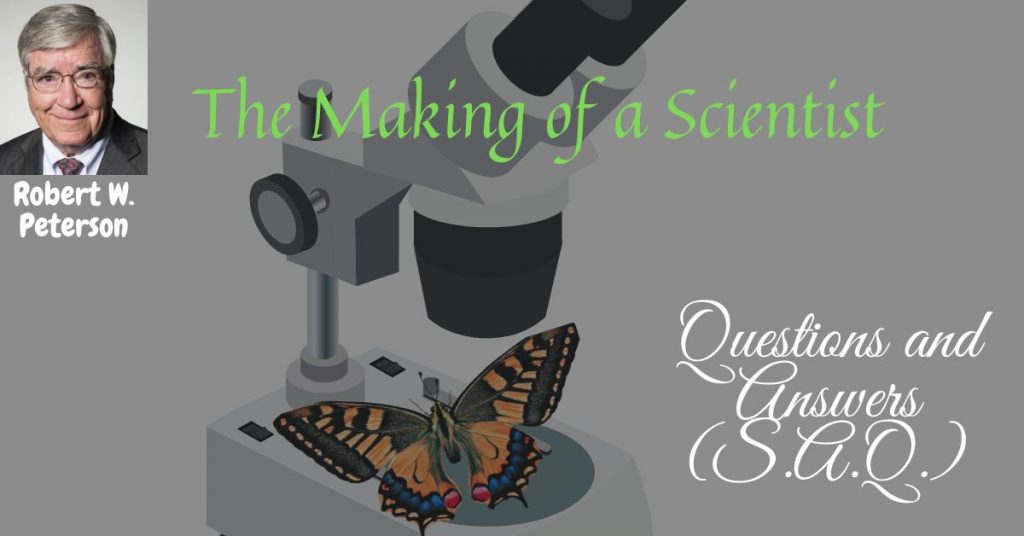
1)Where did Ebright grow up? What was the one thing that he could do there and why?
Ans. Ebright grew up North of Reading, Pennsylvania.
The one thing that he could do was – collect things because there was none to play with them football or baseball.
2)What were the other things that he used to do at that time?
Ans. Besides collecting butterflies he used to collect rocks, fossils and coins. Sometimes he used to gaze at the stars throughout the night like an eager astronomer.
3)How did Ebright’s mother help him to encourage different things?
Ans. Ebright’s mother helped him to encourage different things. Her mother took him on trips. She bought telescopes, microscopes, cameras, mounting materials and other equipment. In this way, she tried to encourage his interests.
4)How was Ebright as a student in the school?
Ans. Ebright was a bright student in the school. He earned top grades in the class.
5)How did Ebright spend his time with his mother?
Ans. As Ebright had no friends, his mother was his only companion. Ebright was her whole life after his father died. They used to spend every evening at the dining table. Her mother found work for him and he learnt things with great interest.
6)What opened the world of science to Ebright?
Ans. In the second grade, Ebright collected twenty-five species of butterflies near his hometown. It would have been the end of his butterfly collection. But his mother presented him with a book named ‘The Travels of Monarch X’. That book opened the world of science to the eager young collector as it showed him how monarch butterflies migrate to Central America.
7)Why did Ebright start tagging butterflies?
Ans. Mother of Ebright gave him a book called ‘The Travels of Monarch X’. This book opened the world of science to young Ebright. The author of the book Dr Fredrick A. Urquhart invited his readers to help study butterfly migrations by tagging butterflies. So, Ebright started tagging butterflies.
8)How did Ebright make his project of tagging the butterflies successful?
Ans. It is difficult for Ebright to chase the butterflies one by one. So he raised a flock of butterflies in his basement. He would catch a female monarch and take her eggs. He raised them through their life cycle from egg to caterpillar, then to pupa to adult butterfly. After that, he would tag the butterflies’ wings and let them go.
9)Why did Ebright lose interest in tagging the butterflies?
Ans. The act of tagging the butterflies was tedious and there was not much feedback. Only two butterflies were recaptured that he had tagged before and the distance was not more than seventy-five miles from his residence. So, Ebright lost interest in tagging the butterflies.
10)What was Ebright’s first project in a competition? What did he learn from the competition?
Ans. When Ebright was in the seventh grade, he entered a country science fair. His entry was slides of frog tissues which he showed under a microscope. It was his first project in a competition. Unfortunately, he did not win any prize. He learnt from the competition that only a neat display of facts won’t work. He must work hard to do a real experiment.
11)Why did Ebright write to Dr Urquhart?
Ans. Inexperienced Ebright failed to win any prize in his first science competition. He realized that he should try to do a real experiment. For that purpose, he wrote to Dr Urquhart for experiment ideas.
12)What made Ebright busy all through high school?
Ans. After being unsuccessful in a science competition, Ebright was predetermined to do a real experiment. So, he wrote to Dr Urquhart for project ideas. Dr Urquhart offered him a stack of suggestions for scientific experiments and these ideas made Ebright busy all through high school.
13)What did Ebright do for his eighth-grade project? Or. What was the project Ebright in the eighth grade? What was the result?
Ans. Ebright tried to find the cause of a viral disease that kills all monarch caterpillars every few years. He thought the disease might be carried by a beetle. So, he tried to raise the caterpillar in the presence of beetles. But he did not get any results to prove his thought.
Yet his enthusiasm was recognised and he won a prize.
14)What was Ebright’s next year’s science fair project after his eighth-grade project?
Ans. The next year, Ebright’s science fair project after his eighth-grade project was testing the theory that viceroy butterflies copy monarchs. The theory was that viceroys wanted to look like monarchs because birds do not eat monarch butterflies. On the other hand, viceroys tasted good to birds.
15)Why did viceroy butterflies copy the monarch?
Ans. The viceroy butterflies taste good to birds but they dislike monarchs. So, to defend themselves from prey to birds, viceroy butterflies copy the monarch.
16)What was the project that gave Ebright first place in the zoology division and third overall in the country science fair?
Ans. Earlier researchers showed that viceroy butterflies copy monarchs to avoid death from birds. But Ebright found that a starling would not eat ordinary bird food. It would eat all the monarchs. This was the project that gave Ebright first place in the zoology division and third overall in the country science.
17)What is the purpose of twelve tiny gold spots on a monarch pupa? Or. What was Ebright’s new theory on the life of cells?
Ans. Ebright proved that the twelve tiny gold spots on a monarch pupa are not just ornamental. He showed that the spots produce a hormone necessary for the butterfly’s full development.
18)What was Ebright’s achievement in his senior year?
Ans. In his senior year, Ebright grew cells from a monarch’s wing in a culture. He showed that cells would divide and develop into normal butterfly wing scales if only they were fed the hormone from the gold spots.
19)How did Ebright able to identify the hormone’s chemical structure? Or. Which project of Ebright enabled him to work at the army lab and at the U.S. Department of Agriculture?
Ans. In the laboratory of the U.S. Department of Agriculture, Ebright worked hard on the hormone from the gold spots of monarch pupa. There he used the sophisticated instruments of the laboratory and was able to identify the hormone’s chemical structure.
20)How did Ebright get an answer to one of biology’s puzzles? Or. How did Ebright get the idea of his new theory about cell life?
Ans. While Ebright was looking at X-ray photos of the chemical structure of the hormone, he got the idea of his new theory about cell life. The photos gave him the answer to the puzzles: how the cell can read the blueprint of its DNA.
21) What is DNA according to the author of the story, ‘The Making of a Scientist’?
Ans. According to Robert W Peterson, DNA is the substance in the nucleus of a cell that controls heredity. It determines the form and function of the cell. Thus DNA is the blueprint for life.
22)Who was Ebright’s social studies teacher? What did he say about Ebright?
Ans. Richard A. Weiherer was Ebright’s social studies teacher.
He said that Ebright would always give his extra effort. Besides doing all his research, he put in three or four hours at night for debate research. He was not interested in winning prizes but wanted to do the best job.
23)How can the theory of Ebright be beneficial to humanity?
Ans. If the theory of Ebright proves correct, it will be a big step toward understanding the processes of life. It might lead to new ideas for preventing cancer and other diseases.
24)How did Ebright excite the world of science at the age of twenty-two?
Ans. Richard Ebright excited the world of science at the age of twenty-two with a new theory on how cells work. It happened when Ebright and his college roommate explained the theory and published it in the ‘Proceedings of the National Academy of Science.
25)What are the other interests of Ebright?
Ans. In spite of collecting butterflies and researching on them, Ebright had other interests. He was a champion debater, a great public speaker, a good canoeist and an all-around outdoor person. He was also an expert photographer of nature and scientific exhibits.
26)Mention any two contributions of Ebright to the world of science.
Ans. i) Ebright discovered a hormone from the tiny gold spots of a monarch pupa that helps him to make the theory on the life of cells.
ii)He identified the chemical structure of the hormone and gave the blueprint of DNA.
Also, read: 1)‘A Question of Trust’ by Victor Canning – Questions and Answers(S.A.Q.), Class 10, CBSE
2)‘Footprints without Feet’ by H.G. Wells – Questions and Answers(S.A.Q.), Class 10, CBSE
3)‘The Necklace’ by Guy De Maupassant – Questions and Answers(S.A.Q.), Class 10, CBSE
